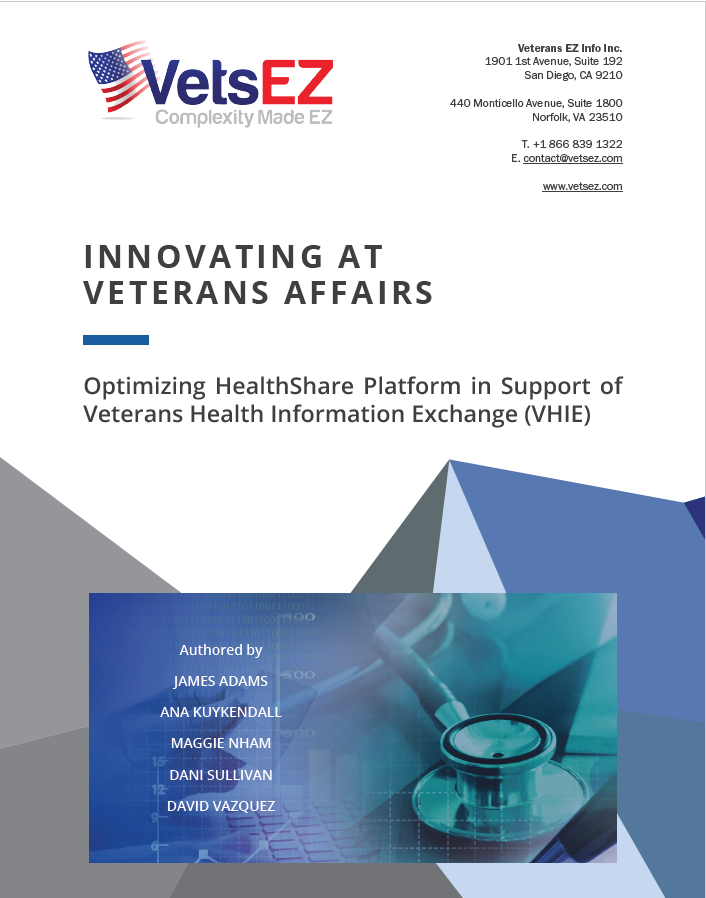NEWS & ARTICLES
INNOVATING AT VETERANS AFFAIRS
Optimizing HealthShare Platform in Support of Veterans Health Information Exchange (VHIE)
by James Adams, Ana Kuykendall, Maggie Nham, Dani Sullivan, David Vazquez
Client Situation
The Department of Veterans Affairs (VA) has shifted its approach for software development away from custom software products over to the implementation of commercial off the shelf (COTS) technologies due in part to the extreme costs incurred to maintain aging custom developed products and systems. In 2017, VA acquired the HealthShare COTS product as a Veterans Health Information Exchange (VHIE) solution, replacing the custom built VHIE e-Health Exchange (eHX) and Veteran Authorization and Preferences (VAP) legacy systems. Multiple teams from both the Veterans Health Administration (VHA) and the Office of Information and Technology (OIT) were engaged to implement the HealthShare product on the Veterans Data Integration and Federation Enterprise Platform (VDIF) and to migrate patient data from the legacy products. In mid-2018, VetsEZ was designated by OIT as the lead VHIE development team for migration of the legacy VHIE products (referred to herein as the “VetsEZ VHIE Team”).
During the system transition, the coordination of separate but directly related teams and efforts were well planned through the synchronization of complex integrated master schedules. In many instances, project teams delivered top quality results in alignment with congressionally mandated objectives and timelines.
Misaligned Schedule Creates Technical Challenge
In order to replace the VHIE legacy applications, HealthShare needed to support legacy functional requirements and interface quickly with complete and accurate data. Out of the box, HealthShare did not support all types of clinical data inputs (e.g. On-Demand documents) required by VA. To close this gap, the VetsEZ VHIE Team created a software customization, so HealthShare had the necessary registration capabilities to support additional types of data inputs. The customization allowed the product to process the document types received and requested; as new data types were received, the system registered the incoming data type so that it could be processed in HealthShare accordingly. The VHIE application enhancement registered these additional On-Demand documents as data to be inserted and updated into HealthShare. The solution used a customization of HealthShare’s Clinical Message Delivery subsystem.
During the course of registering all of the data inputs in HealthShare, the VDIF HealthShare Implementation Team pre-loaded patient data into HealthShare’s production environment much earlier than anticipated due to requirements from a separate but connected project. Unfortunately, this data pre-load took place before all required data inputs were registered and implemented in HealthShare by the VetsEZ VHIE Team. The pre-load caused misalignment with the data required for HealthShare outputs (reports and documents generated), including the VHIE scheduled patient reports (CCD, CCDA, etc.). Because of this, additional patient data and reports required for accurate records could not be included in HealthShare generated documents, causing possible patient safety concerns.
VetsEZ Provides Resolution with Additional Benefits
VetsEZ’s VHIE Team swiftly responded to the problem with an innovative solution: “Documentation Registration Utility” (DRU), designed to trigger the registration of documents from data already loaded within HealthShare. DRU allows additional document types to be registered as they are introduced. The design of DRU made it unnecessary to un/re-load any of the data, which saved a tremendous amount of time and energy across multiple impacted teams.
Upon completion of its development, VetsEZ’s DRU was tested in a pre-production environment. During its initial execution, the utility not only successfully registered documents as designed, but it also revealed platform-level optimization opportunities. For example, metrics were gathered to measure the rate of document type registrations within a projected runtime of two months (uninterrupted and unoptimized for the duration). The VetsEZ VHIE Team shared these metrics and findings along with recommendations on segments of the architecture to optimize.
The VDIF HealthShare Implementation Team has implemented the recommendations from the VetsEZ DRU results, creating immediate benefits for the VA:
- Mitigated patient safety risk
- Reduced DRU runtime from two months to 5 days
- Responded efficiently to system issues and identified resolutions
- Identified opportunities for platform-level efficiencies and optimizations, thereby allowing the VA to deliver better results more quickly to our nation’s heroes
- Created a utility that dynamically addresses registering future document types.
“VetsEZ’s atmosphere of innovation allowed us to design and develop DRU in a very short amount of time.”
Recent Blog Posts
- VetsEZ Awarded Community Image Exchange Service (CIES) Contract
- VetsEZ Awarded U.S. Forest Service Contract for Management and Process Support Services (MAPSS)
- VetsEZ Awarded VA Contract for Active Directory Domain Consolidation
- VetsEZ Awarded VA Contract for Standards and COTS Integration Platform (SCIP) Sustainment, Program Management, Configuration Management, and Virtual Private Network Services
- VetsEZ Awarded VA Contract for Consolidated Mail Outpatient Pharmacy (CMOP) Support
- VetsEZ Awarded VA Contract for the Office of Identity, Credential, and Access Management (OICAM)
- VetsEZ Awarded VA Contract for Veterans Benefit Management System (VBMS) Deployment Release Management and Help Desk Tier 2 and Deployment Support
- VetsEZ Awarded VA Contract for Data Syndication and Data Strategy Support
- VetsEZ Awarded a $75 Million Contract for Community Care DevSecOps Support
- VA OIG IT Strategic Support Services Award

